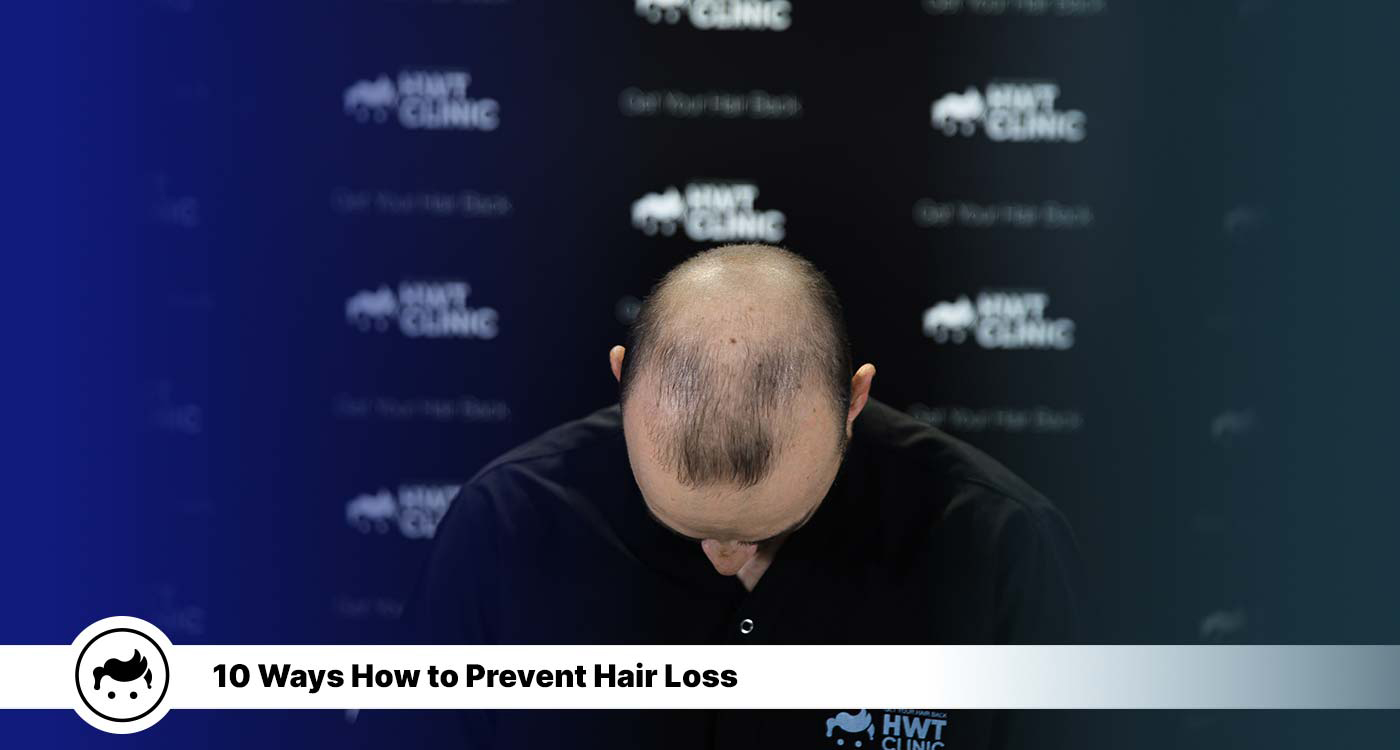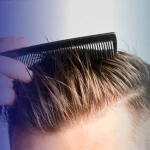
Table Of Content
Hair loss is the thinning or complete absence of hair on one’s head. Genetic factors, hormonal changes, medical conditions, or aging cause it. According to NYU Langone Medical Center, more than 80% of men and nearly 50% of women experience significant hair loss in their lifetime. Factors such as hormonal changes, nutritional deficiencies, stress, medications, genetics, health conditions or lifestyle contribute to hair loss. It is normal to shed 50-100 hairs per day as hair reaches the end of its growth potential and falls out. The human body has around 5 million follicles, including 100,000 on the head alone. However, the number of present follicles doesn’t indicate how many are functioning and producing new growth. Approximately 50% of women experience hair loss by age 50. Hair loss significantly impacts an individual’s physical and mental well-being. Learning how to prevent balding can involve maintaining a healthy diet, reducing stress, and using hair care products designed to strengthen hair and promote growth. Preventing hair loss involves taking steps such as eating a healthy balanced diet, exercising regularly, reducing stress levels, avoiding harsh chemicals or treatments for hair care, maintaining good hygiene, and seeing a doctor if necessary. Making the changes help reduce the chances of hair loss and keeps people looking and feeling their best. Here are ten ways how to prevent hair loss:
Refrain from using hairstyles that pull on the hair for further hair loss prevention. It is because tight braids, cornrows, and other styles which pull on the scalp cause traction alopecia, or gradual hair thinning. Wearing protective hairstyles such as a silk scarf or loose up do helps reduce the risk of further hair loss. It helps promote healthier hair growth and prevent additional damage from pulling and tugging at the scalp by avoiding the mentioned hairstyling techniques. It is important to choose hairstyling products carefully since some contain harsh chemicals that contribute to dryness, breakage and thinning of the hair. The benefit of refraining from using hairstyles that pull on the hair for further hair loss prevention is two-fold: firstly, it reduces the chances of developing traction alopecia by preventing damage to the roots of the hair; secondly, it encourages healthy hair growth by avoiding drying and damaging styling techniques and chemical-based products. It is one of the best ways to ensure continued healthy hair growth while reducing the risk of further hair loss.
Using low heat when styling hair is an effective way to prevent further hair loss for several reasons. First, the high heat causes damage to the hair shaft, leading to breakage and thinning of the hair. Low heat, however, is less likely to cause damage and helps maintain the hair’s health. Additionally, using low heat helps to prevent damage to the scalp. High heat causes dryness and irritation, which leads to hair loss and other scalp conditions. Low heat is less likely to irritate and helps maintain the scalp’s health. One of the benefits of using low heat when styling hair is that it is less damaging to the hair and scalp and helps to prevent further hair loss. An obstacle to using low heat is that it takes longer to style hair, as the low heat setting is not as powerful as the high heat setting. One needs to use a hair dryer or styling tool for a longer period or use a diffuser attachment to help distribute the heat more evenly. Overall, it is one of the best ways to prevent further hair loss, as it is less damaging to the hair and scalp and helps to maintain the health of hair. It is a safe and simple way to style hair without the risk of causing harm.
Bleaching or chemically treating hair causes damage to the hair shaft and follicles, leading to breakage and hair loss. The chemicals used in the treatments strip the hair of its natural oils and proteins, making it more fragile and prone to damage. Additionally, the treatments irritate the scalp, which leads to hair loss. It is best to avoid bleaching or chemically treating the hair to prevent further hair loss. Instead, try using natural hair care products and techniques, such as gentle shampoos and conditioners, avoiding heat styling tools, and limiting hair products that contain harsh chemicals. One of the benefits of not bleaching or chemically treating hair is that it helps preserve a hair’s natural health and strength. It helps to prevent further hair loss and promotes healthy hair growth. It helps to minimize the risk of scalp irritation and damage to the hair shaft and follicles. An obstacle while avoiding bleaching or chemically treating hair is that it is not suitable for everyone, as some people require the treatments for a specific look.
Moreover, people find it difficult to maintain their hair color or change their style without bleaching or chemically treated hair. Not bleaching or chemically treating hair is one of the best ways to prevent further hair loss because it helps preserve hair’s natural health and strength and minimize the risk of scalp irritation and damage to the hair shaft and follicles. It is a safe and effective way to promote healthy hair growth and prevent further hair loss.
A mild shampoo for hair helps avoid further loss due to several motives. Effective shampoos take away the hair’s natural oils, causing it to become weak and dry, which results in breakage and shedding. A delicate shampoo cleanses without damaging valuable oils, making it healthier and more robust. Additionally, using an appropriate gentle shampoo aids in preventing scalp irritation and dandruff, both of which add to hair thinning. Many mild shampoos contain elements to soothe the scalp while encouraging healthy growth. One downside when using a mild shampoo is that it isn’t as great at getting rid of styling products or build-up. The issue is tackled by washing with a clarifying shampoo once every week and then utilizing a soft shampoo daily. Overall, opting for a gentle shampoo helps prevent extra hair fall since it keeps the hair & scalp balanced whilst avoiding damage that triggers hair loss. It is wise to think about different factors causing baldness, so consulting with a medical doctor or trichologist to identify the root cause and prescribe the ideal treatment plan is recommended.
Using a gentle, natural-fiber brush on the hair helps prevent hair loss for several reasons, such as distributing the scalp’s natural oils throughout the hair, which helps keep the hair moisturized and less prone to breakage. Natural fiber brushes are less likely to damage the hair than synthetic brushes, which cause friction and tugging, leading to breakage. Brushing the hair with a natural-fiber brush helps increase blood flow to the scalp, which promotes healthy hair growth. Obstacles to using a natural-fiber brush include difficulty finding one at a store and the potential for the brush to be more expensive than synthetic brushes. However, using a natural-fiber brush is considered one of the best ways to prevent hair loss because it is a gentle and non-invasive method of maintaining the health of the hair and scalp. It helps prevent damage and breakage, promotes healthy hair growth, and keeps the hair moisturized and looking its best.
Trying light treatment with modest intensity for further hair loss prevention is a popular option among individuals experiencing hair loss. The method uses low-level laser therapy (LLLT) to stimulate hair growth and prevent further hair loss. The reasons for choosing it include its non-invasive nature and lack of side effects, as well as its effectiveness in promoting hair growth. The benefit of the treatment is that it is done in the comfort of one’s own home and is relatively inexpensive compared to other hair loss treatments. However, there are some obstacles to the method, such as the need for consistent use and the possibility of mixed results. Light treatment with modest intensity is still considered one of the best ways to prevent further hair loss because of its ability to promote hair growth and prevent hair loss without using harsh chemicals or invasive procedures, despite the obstacles.
Eating a protein-packed diet is one of the best approaches to stave off additional hair loss for various reasons. The main justification is that locks are made up of a protein known as keratin, so consuming enough protein in meals is necessary for hair expansion and upkeep. Besides, a deficiency of protein in a diet brings about thinning and damage to hair. Moreover, the rewards of having a protein-dense diet stretch out to general hair well-being, improving its quality and elasticity. However, some impediments make it tough to keep up a protein-filled diet, like dietary constraints or sensitivities limiting from having certain proteins.
Additionally, some individuals find it hard to include enough protein in their food due to financial restrictions or lack of access to healthy protein sources. It is still essential to endeavor to include enough protein in a diet for hair health despite such challenges. It is done by incorporating lean meats, fish, eggs and dairy products into a diet alongside plant-sourced proteins like beans, nuts and seeds. A high-protein diet is one of the most effective ways to avoid further hair loss, as it nourishes the follicles and helps with hair growth.
Yoga is an effective way to decrease stress and prevent further hair loss. Studies have shown it reduces tension and anxiety, two frequent causes of balding. The practice combines physical poses, breathing techniques, and meditation to soothe the mind and body by decreasing cortisol levels. It leads to less hair fallout and improved overall scalp health. Plus, yoga boosts circulation, which in turn encourages more growth. However, squeezing the activity into a busy day is tough, finding suitable instructors is tricky, and certain postures are not doable due to individual restrictions. Yoga remains one of the top options for reducing strain while concurrently tending to mane health, thanks to its comprehensive approach and proven advantages on the psyche and physique.
Dealing with stress is an effective way to stop hair loss due to its influence on hormonal balance. Stress prompts the body to create cortisol, interfering with normal hair growth and causing balding. Cortisol amounts are regulated, and thinning is averted by regulating tension levels. People try relaxation activities like meditation, yoga, or breathing exercises to help manage stress. Additionally, exercising regularly has been proven to reduce stress and improve overall health. Trying to avoid stressful circumstances such as certain persons, places, or events is useful. It isn’t very easy to put into practice. It takes time and commitment to engage in calming practices or exercise, and trying to stay away from stress triggers isn’t always achievable. However, some individuals are more prone to anxiety than others, so they need to make a greater effort when managing it. Keeping strain in check is one of the best approaches to protect against further hair loss, since it deals with the root issue instead of merely treating the symptoms.
Taking the time to massage the scalp helps keep the hair looking healthy. It encourages better blood flow, which brings oxygen and nutrients to the follicles. It makes them stronger, which helps stop hair loss. It clears dead skin cells and dirt that block up follicles and cause balding. Massaging the scalp greatly reduces stress, a major reason people suffer from hair thinning or falling out. The only downsides? An individual needs to put in the effort, which is too intense if they have a sensitive scalp condition. However, with some time and dedication, massaging the scalp regularly makes a difference in keeping the hair strong and vibrant.
Hair loss in men is a difficult problem to tackle. Fortunately, there are steps to take to help reduce or prevent it from happening. Here are some of the best methods for hair loss prevention in men:
Taking the steps significantly improves the chances of preventing hair loss in men. Healthy foods provide essential nutrients to the body while avoiding stress and keeping the scalp clean, reducing damage to existing hairs. Finally, exercising regularly helps increase blood flow to the scalp, encouraging stronger hair growth. All of the measures combined create an effective approach towards preventing hair loss in men.
Hair loss in women is difficult and distressing, but the right steps reduce the risk. Here are some of the best methods for hair loss prevention:
It helps minimize the risk of hair loss and promotes healthy hair growth. Eating well, managing stress, using gentle products, taking supplements, and visiting a doctor are all important components of successful hair loss prevention in women.
Pregnancy is a stressful time, and it sometimes results in hair loss. Fortunately, some steps help prevent the issue. Here is what to do to keep the hair healthy during pregnancy:
The methods are some of the best for preventing hair loss during pregnancy because they focus on improving overall hair health rather than just treating the symptoms. Each step is important since all three work together to create healthier hair. Plus, the methods don’t require special products or expensive trips to the salon, making them affordable and easy to follow.
Hair loss after giving birth is a common experience for many new mothers. Thankfully, there are steps to take to help prevent it. Here are some of the best methods for preventing hair loss after childbirth:
Hair loss is a common side effect of chemotherapy, but there are ways to prevent it. Here are some of the best methods:
The steps are important to prevent hair loss during chemotherapy because they minimize damage from the drugs and environment. Furthermore, eating well, staying hydrated, and gently handling the hair promotes healthy growth and helps prevent additional loss.
Hair loss is an undesirable condition characterized by the shedding or thinning of hair from one’s scalp. It occurs in males and females, although it tends to be more common among men. Hair loss happens due to aging, genetics, stress, hormonal imbalances, illness, medication side effects, environmental influences, poor nutrition, physical trauma, and excessive styling techniques. Hair loss is temporary or permanent, depending on its cause. Common signs of hair loss include bald patches, receding hairlines, increased shedding of hair when combing or brushing, reduced density of strands on the scalp, and visible hair thinning. The hair stops growing altogether in some cases. Certain treatments help slow down or stop hair loss for people who suffer from it. It involves medications (e.g., minoxidil), lifestyle changes (e.g., reducing stress levels), dietary modifications (e.g., taking nutritional supplements or eating foods rich in vitamins and minerals), topical solutions (e.g., shampoos containing biotin) or surgical interventions (e.g., Turkey hair transplants). Losing hair is very distressing for many people, affecting their self-esteem and confidence. Fortunately, with the right care and treatment options available today, people suffering from the condition still have a head full of healthy locks they are proud of.
Hair loss is a distressing problem, and it’s important to understand the causes. Listed below are some:
All of the causes mentioned above of hair loss are capable of affecting individuals at any stage of their life.
Hair loss is a common issue that affects people of all ages. It causes noticeable thinning on the scalp, as well as patches of baldness. Hair loss is temporary or permanent and occurs gradually over time or suddenly. Some of the common symptoms of hair loss are:
Hair loss is a frustrating problem for many individuals, but natural remedies are used at home to combat the issue. Natural home remedies effectively address hair loss as an alternative to costly medical treatments or chemical-based products.
The best hair loss treatment varies depending on the underlying cause of the hair loss and the individual’s preferences and needs. However, some of the most commonly used and effective treatments for hair loss include:
Knowing the best hair loss treatments is a lifesaver. Understanding the causes of hair loss and how to address them from a medical and lifestyle standpoint helps maintain a full head of hair. The key is to identify the underlying cause of hair loss, whether an underlying medical condition or something more preventable such as stress or poor diet and then apply the appropriate treatment. Knowing the best hair loss treatments makes all the difference in restoring hair growth and stopping further thinning or balding. Plus, depending on the treatment, there are turkey hair transplant cost savings as well. For instance, certain medications are expensive, but investing in an appropriate regimen is a more cost-effective solution in the long run.
Yes, hair transplants help with hair loss. Hair transplantation is a surgical procedure in which hairs from one part of the scalp are removed and then transplanted to areas with thinning or baldness. The main benefit of the hair transplant treatment is that it provides a permanent solution to hair loss, as opposed to temporary fixes like wigs, creams, and other products. Individual hairs (follicles) are moved from the back of the head, where they usually remain unaffected by hair loss, to the affected area on the top of the head. The new follicles continue to grow just like the old ones did before the surgery, after recovery.
No, hair loss is not permanent. Various factors, including genetics, hormones, certain medications and medical treatments, age, stress, diet and nutrition, scalp infections, or an autoimmune condition, cause hair loss. The hair stops growing temporarily, but returns once the underlying issue has been resolved. The most common form of hair loss is male pattern baldness, which affects up to 70% of men at some point in their lives. There are medications available that slow down the process and even promote new hair growth.
Additionally, lifestyle changes such as using specialized shampoos, avoiding harsh chemical treatments on the scalp, reducing stress levels, eating a healthy balanced diet with plenty of vitamins and minerals, and avoiding tight hairstyles help to prevent and treat hair loss. How long hair stays gone depends on why an individual is losing it, some causes, like hereditary factors, are permanent, while others, like certain illnesses and medicines, are reversed after they stop. Plus, when an individual experiences treatments like chemo, they usually have their hair returned afterwards.




